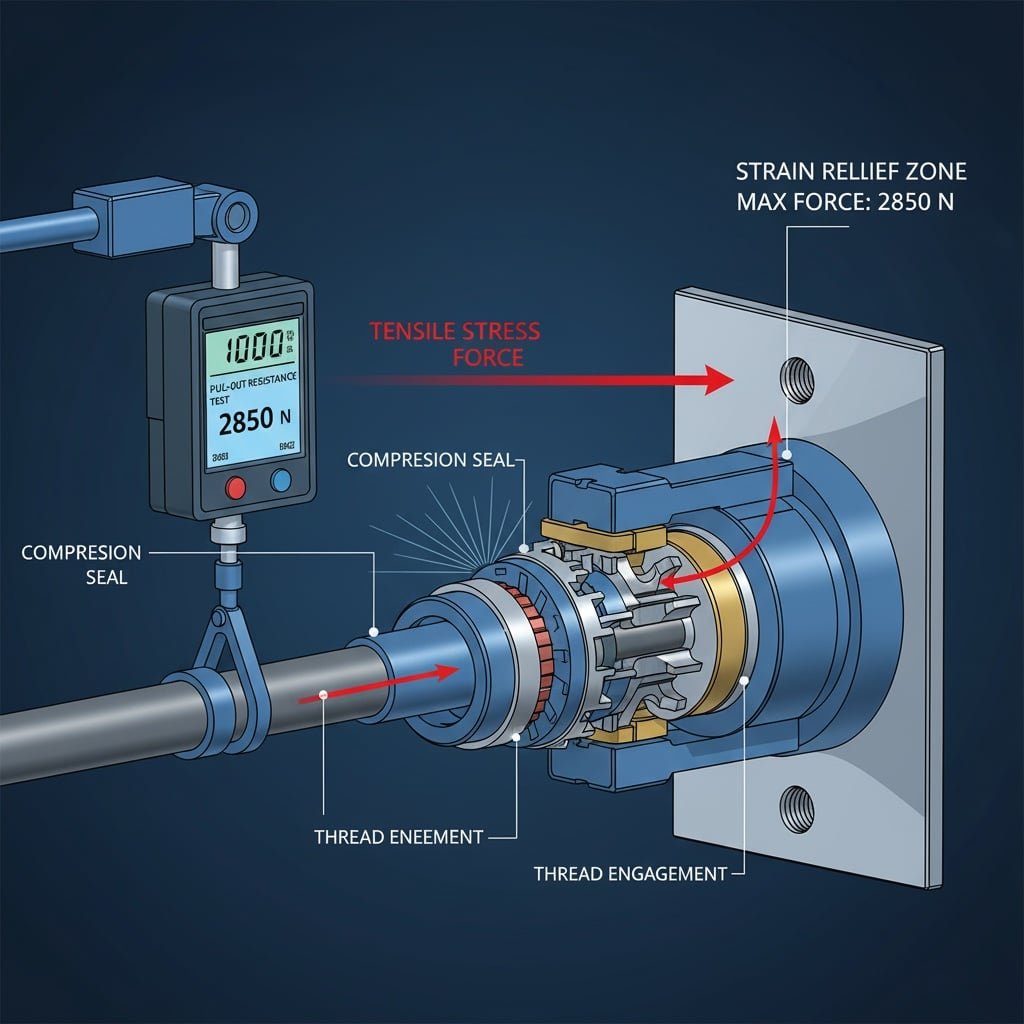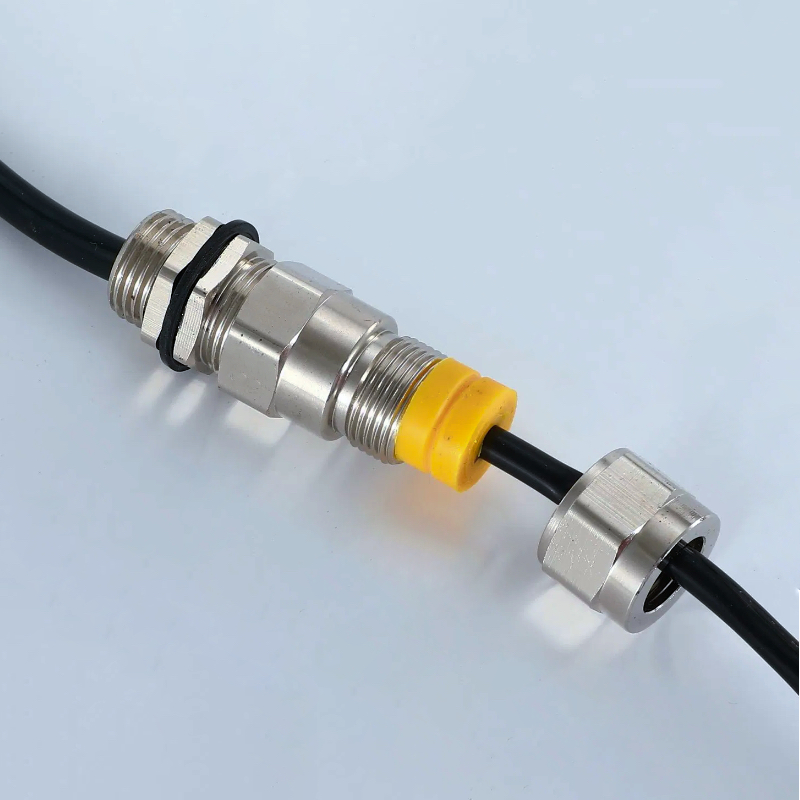
Imagine discovering that your critical cable connections have failed during a routine inspection, causing unexpected downtime and potentially dangerous situations. Pull-out resistance failures in cable gland assemblies are more common than most engineers realize, often resulting from inadequate testing procedures or improper installation techniques.
Validarea rezistenței la smulgere necesită teste sistematice utilizând echipamente calibrate pentru a aplica sarcini specificate, măsurând în același timp deplasarea cablului și integritatea conexiunii. This process ensures your cable gland assemblies meet industry standards and provide reliable long-term performance in demanding applications.
Just last week, I received an urgent call from Marcus, a project manager at a wind farm in Denmark. Several of their turbine cable connections had failed during a storm, causing significant power generation losses. The root cause? Inadequate pull-out resistance validation during installation. This costly lesson reinforced why proper testing procedures are absolutely critical for mission-critical applications.
Tabla de conținut
- What Is Pull-Out Resistance and Why Does It Matter?
- Which Standards Govern Pull-Out Resistance Testing?
- How Do You Perform Pull-Out Resistance Testing?
- What Are Common Testing Mistakes to Avoid?
- ÎNTREBĂRI FRECVENTE
What Is Pull-Out Resistance and Why Does It Matter?
Pull-out resistance testing validates the mechanical integrity of cable gland assemblies under tensile stress1 conditions that occur during installation and operation.
Pull-out resistance measures the maximum force a cable gland assembly can withstand before the cable separates from the gland body, ensuring reliable connections in high-stress environments. This critical parameter determines whether your installation will maintain continuitatea electrică2 and environmental sealing under mechanical stress.

Understanding the Mechanics
Cable gland assemblies rely on several components working together to provide pull-out resistance:
- Compression seals that grip the cable outer jacket
- Strain relief mechanisms that distribute mechanical loads
- Clamping elements that secure the cable within the gland body
- Angajarea firului that maintains assembly integrity
The interaction between these components determines the overall pull-out resistance performance. At Bepto, we’ve engineered our cable glands with optimized grip geometries and high-quality sealing materials to maximize pull-out resistance while maintaining ease of installation.
Aplicații critice
Pull-out resistance becomes especially important in applications involving:
- Vibration exposure in machinery and transportation
- Ciclism termic that causes expansion and contraction
- Installation stress during cable pulling operations
- Environmental loads from wind, seismic activity, or structural movement
I remember working with Ahmed, an electrical contractor in Abu Dhabi, who was installing cable systems in a petrochemical facility. The extreme temperature variations and vibration from nearby equipment demanded cable glands with exceptional pull-out resistance. We provided stainless steel cable glands with enhanced grip designs that exceeded the required 500N pull-out force by 40%, ensuring long-term reliability in this challenging environment.
Which Standards Govern Pull-Out Resistance Testing?
International standards provide specific testing procedures and acceptance criteria for cable gland pull-out resistance validation.
IEC 624443 și UL 514B4 are the primary standards defining pull-out resistance testing methods, specifying test loads, procedures, and acceptance criteria for different cable gland types and applications. These standards ensure consistent testing approaches and reliable performance validation across manufacturers and applications.
Key Testing Standards
| Standard | Aplicație | Test Load | Durată |
|---|---|---|---|
| IEC 62444 | Garnituri generale pentru cabluri | 50-500N (based on size) | 1 minute |
| UL 514B | North American markets | Varies by cable size | 1 minute |
| IEC 60079-7 | Glande antideflagrante | Enhanced requirements | 1 minute |
| BS EN 50262 | European applications | Size-dependent loads | 1 minute |
Test Load Determination
The required test load depends on several factors:
- Cable outer diameter – larger cables require higher test loads
- Cable type – armored cables have different requirements than standard cables
- Application environment – harsh conditions may require enhanced testing
- Gland material – metal glands typically have higher resistance than plastic
Understanding these requirements is crucial for proper validation. Our technical team at Bepto provides detailed testing specifications for each cable gland model, ensuring customers can perform appropriate validation testing for their specific applications.
How Do You Perform Pull-Out Resistance Testing?
Proper pull-out resistance testing requires systematic procedures using calibrated equipment and standardized test methods.
The testing process involves securing the cable gland assembly, applying gradually increasing tensile force to the cable, and measuring the maximum load before failure or excessive displacement occurs. This methodical approach ensures accurate and repeatable results that validate assembly performance.
Required Equipment
Essential testing equipment includes:
- Tensile testing machine with appropriate load capacity
- Calibrated load cell for accurate force measurement
- Displacement measuring device to track cable movement
- Test fixtures to secure the cable gland assembly
- Data recording system for documentation
Procedura de testare pas cu pas
Faza de pregătire
– Install cable in gland according to manufacturer specifications
– Verify proper torque on all threaded components
– Allow assembly to stabilize at test temperature
– Connect measuring equipment and verify calibrationInitial Inspection
– Document cable position and gland configuration
– Check for proper seal compression and alignment
– Verify thread engagement and component integrity
– Record baseline measurementsLoad Application
– Apply tensile force gradually at specified rate (typically 50N/minute)
_ – Monitor cable displacement continuously
– Record force and displacement data throughout test
– Continue until reaching specified test load or failureResults Evaluation
– Assess maximum load achieved before failure
– Measure permanent cable displacement
– Inspect assembly for damage or degradation
– Compare results to standard requirements
Cerințe privind documentația
Comprehensive documentation should include:
- Test setup configuration and equipment calibration
- Condiții de mediu în timpul testării
- Load-displacement curves and maximum values
- Visual inspection results before and after testing
- Pass/fail determination based on applicable standards
What Are Common Testing Mistakes to Avoid?
Understanding common testing errors helps ensure accurate pull-out resistance validation and reliable results.
The most frequent mistakes include improper installation torque, inadequate test fixture design, incorrect load application rates, and insufficient documentation of test conditions. These errors can lead to false results and unreliable performance predictions.
Installation-Related Errors
Many testing failures stem from improper assembly:
- Strângere insuficientă threaded components reduces clamping force
- Strângere excesivă can damage seals or thread engagement
- Misaligned cables create uneven stress distribution
- Contaminated threads prevent proper engagement
Testing Procedure Mistakes
Common procedural errors include:
- Excessive loading rates that don’t allow stress distribution
- Inadequate stabilization time before testing
- Improper fixture design that introduces stress concentrations
- Temperature variations that affect material properties
Documentation Deficiencies
Incomplete documentation can invalidate test results:
- Missing calibration records for testing equipment
- Inadequate environmental condition recording
- Insufficient photographic documentation
- Unclear pass/fail criteria application
At Bepto, we provide comprehensive testing guidelines and support materials to help customers avoid these common pitfalls. Our technical team regularly conducts training sessions on proper testing procedures, ensuring reliable validation results for critical applications.
Concluzie
Validating pull-out resistance is essential for ensuring reliable cable gland performance in demanding applications. By following standardized testing procedures, using calibrated equipment, and avoiding common mistakes, engineers can confidently specify cable gland assemblies that will provide long-term reliability. At Bepto, we’re committed to supporting our customers with comprehensive testing guidance, high-quality products, and technical expertise to ensure successful installations that meet the most stringent performance requirements.
ÎNTREBĂRI FRECVENTE
Q: What pull-out force should I test my cable glands to?
A: Test loads depend on cable size and applicable standards, typically ranging from 50N for small cables to 500N for larger installations. Consult IEC 62444 or UL 514B for specific requirements based on your cable diameter and application.
Q: How often should I perform pull-out resistance testing?
A: Perform testing during initial installation validation, after any modifications to the assembly, and as part of periodic maintenance programs. Critical applications may require annual testing to ensure continued performance.
Q: Can I reuse a cable gland after pull-out testing?
A: Cable glands that pass pull-out testing without permanent deformation can typically be reused, but inspect all sealing components for damage. Replace any damaged seals or components before reinstallation to maintain performance.
Q: What happens if my cable gland fails pull-out testing?
A: Failure indicates improper installation, component damage, or inadequate gland selection. Check installation torque, inspect for damage, and verify the gland is appropriate for your cable type and application requirements.
Q: Do I need special equipment for pull-out resistance testing?
A: Yes, you need a calibrated tensile testing machine with appropriate load capacity, accurate force measurement, and proper test fixtures. Many testing laboratories offer pull-out resistance testing services if you don’t have in-house capabilities.
-
Learn the engineering definition of tensile stress and how it measures pulling force on a material. ↩
-
Understand the concept of an unbroken electrical path and the methods used to verify it. ↩
-
Access the official IEC 62444 standard abstract and details for cable gland testing. ↩
-
Review the scope of the UL 514B standard for conduit, tubing, and cable fittings in North America. ↩



